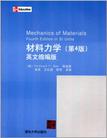材料力学
出版时间:2008-12 出版社:清华大学出版社 作者:比尔 页数:322
内容概要
近年来,国家教育部出台的一系列倡导高等院校开展双语教学、引进原版教材的政策,对于加快我国高等教育改革的步伐,培养具有国际竞争力的高水平技术人才,发挥了积极的促进作用。材料力学也引进了多个版本的英文原版教材,但由于教育体制和教学模式的差异,一时还很难直接用于我国目前的课程教学。缩编和改编是把优秀原版教材引入双语教学的桥梁。我们在开展材料力学双语教学的过程中,针对本专业的特点,尝试在国外优秀教材基础上精选其主体内容并进行适当缩编的方式,取得了较好的效果。通过几年的教学实践我们体会到,缩编的原版教材有内容贴近教学和语言原汁原味等特点,适于教学。
由Ferdinand P.Beer等编写的Mechanics ofMaterials(Fourth Edition in SI
Units)采用以应力为铺路石,以构件变形为主线的体系,符合国内教学改革的主流方向。教材结构清晰、论述严谨、图文并茂,同时还附有少量计算题目。该教材将杆件设计概念贯穿全书,广泛采用三维插图,有助于揭示力学原理、贴近工程实际以及培养学生分析问题、解决问题的能力。书中每章都分别针对基本概念和原理设置多个“Examples
and Sample Problems”和“Homework ProblemSets”,每章后面还设有“Chapter Review
and Summary”、“Review
Problems”和“ComputerProblems”,具有突出“三基”,循序渐进,由简到繁的特色。教材中一些专题性的内容是独立的,便于删减。
经过认真对比研究,我们选择了该书作为基础进行缩编。缩编后的教材保留了原版教材的特色,同时结合国内双语教学的需要适当地删减了一些内容,如去掉了塑性变形(除轴向拉伸与压缩变形以外)等国内材料力学教材都不讲授或很少讲授的内容,精选了部分例题、习题讲解和习题等。
作者简介
作者:(美国)比尔(Ferdinand P. Beer) 改编:张燕 王红囡 彭丽
书籍目录
1 Introduction--Concept of Stress
1.1 Introduction
1.2 Stresses in the Members of a Structure
1.3 Analysis and Design
1.4 Axial Loading; Normal Stress
1.5 Shearing Stress
1.6 Bearing Stress in Connections
1.7 Application to the Analysis and Design of Simple
Structures
Problems 1.1
1.8 Stress on an Oblique Plane under, Axial Loading
1.9 Stress under General Loading Conditions; Components of
Stress
1.10 Design Considerations
Problems 1.2
Review and Summary for Chapter 1
Review Problems
Computer Problems
2 Stress and Strain--Axial Loading
2.1 Introduction
2.2 Normal Strain under Axial Loading
2.3 Stress- Strain Diagram
2.4 Hooke's Law; Modulus of Elasticity
2.5 Elastic versus Plastic Behavior of a Material
2.6 Repeated Loadings; Fatigue
2.7 Deformations of Members under Axial Loading
Problems 2.1
2.8 Statically Indeterminate Problems
Problems 2.2
2.9 Poisson's Ratio
2.10 Multiaxial Loading; Generalized Hooke's Law
2.11 Shearing Strain
Problems 2.3
2.12 Stress and Strain Distribution under Axial Loading;
Saint-Venant's Principle
2.13 Stress Concentrations
Problems 2.4
Review and Summary for Chapter 2
Review Problems
Computer Problems
3 Torsion
3.1 Introduction
3.2 Preliminary Discussion of the Stresses In a Shaft
3.3 Deformations in a Circular Shaft
3.4 Stresses in the Elastic Range
Problems 3.1
3.5 Angle of Twist in the Elastic Range
3.6 Statically Indeterminate Shafts
Problems 3.2
3.7 Design of Transmission Shafts
3.8 Stress Concentrations in Circular Shafts
Problems 3.3
Review and Summary for Chapter 3
Review Problems
Computer Problems
4 Pure Bending
5 Analysis and Design of Beams for Bnding
6 Shearing Stresses in Beams
7 Transformations of Stress and Strain
8 Principal Stresses Under a Given Loaing
9 Deflection of Beams
10 Columns
Appendices
章节摘录
版权页: 插图: when equal and opposite torques are applied to the ends of the "shaft" (Fig. 3.7b).While sliding will not actually take place in a shaft madeof a homogeneous and cohesive material, the tendency for sliding will exist,showing that stresses occur on longitudinal planes as well as on planes perpendicular to the axis of the shaft. 3.3. Deformations in a Circular Shaft Consider a circular shaft that is attached to a fixed support at one end(Fig. 3.8a).If a torque T is applied to the other end, the shaft will twist,with its free end rotating through an angle called the angle of twist(Fig. 3.8b).Observation shows that,within a certain range of values of T,the angle of twist is proportional to T.It also shows that is proportional to the length L of the shaft.In other words,the angle of twist for a shaft of the same material and same cross section,but twice as long,will be twice as large under the same torque T.One purpose of our analysis-will be to find the specific relation existing among,L,and T;another purpose will be to determine the distribution of shearing stresses in the shaft,which we were unable to obtain in the preceding section on the basis of statics alone. At this point,an important property of circular shafts should be noted:When a circular shaft is subjected to torsion,every, cross section remains plane and undistorted.In other words,while the various cross sections along the shaft rotate through different amounts,each cross section rotates as a solid rigid slab.This is illustrated in Fig. 3.9a,which shows the deformations in a rubber model subjected to torsion.The property we are discussing is characteristic of circular shafts,whether solid or hollow;it is not enjoyed by members of noncircular cross section.For example,when a bar of square cross section is subjected to torsion,its various cross sections warp and do not remain plane(Fig.3.9b).
编辑推荐
《材料力学(第4版)(英文缩编版)》由清华大学出版社出版。
图书封面
评论、评分、阅读与下载
用户评论 (总计4条)
- 美国的教材写得相当有水平的
- 慢慢啃吧,很好的书!
- 物流很快,前一天晚上买的,第二天就拿到手了!
- 算是不错的了 就质量而言 印刷还蛮清晰 内容而言 也是非常好的一本教材 插图都是实物图 简单易懂 语言也很好 对于全英文教学来说十分棒
